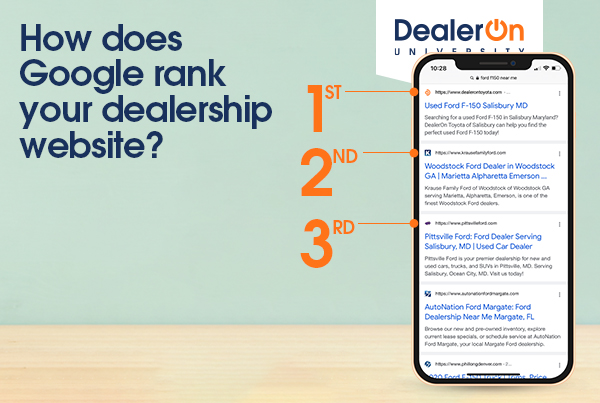

With the ever-changing landscape of Google Search rankings it’s never a bad practice to stop and review your dealership’s Search strategy. Check out the top factors Google uses to determine search ranking and find out how to leverage them for your dealership website.

SEO can be boiled down to a single question: What is Google looking for in a website? In this edition of DealerOn University, we’re going over the top ranking factors Google uses and how to use this information to improve your own SEO.
Top Google Ranking Factors
- Relevant Content
- Focus on Mobile
- User Experience
- Page Speed
- On-Page Optimization
- Internal Link Structure
- Backlinks
Content
Google wants to direct their users to the best content out there, so it’s no wonder that high-quality content is one of the most important ranking factors. But what concrete factors does Google use to determine if content is good or bad? Google measures several factors: including the time spent on your page, bounce rate, and the freshness of your content. In this way, it measures user engagement and gives weight to the new.
Mobile first
As more web-browsing is done on mobile devices, Google has shifted to mobile-first indexing. A responsive design is the best fix for this demand. Google will recognize your site as being optimized for mobile users, rank you more highly accordingly, and your users will get a great experience regardless of device.
Ready to supercharge your SEO?
Schedule a free demo and we’ll show you how!
User experience
While it might be hard to imagine a search algorithm measuring for user experience, Google uses its Core Web Vitals to get an idea of how users react to your page. The Core Web Vitals look at the following three things: load speed, how quickly a page can be clicked on, and how stable the content is as it loads.
SEO can be boiled down to a single question: What is Google looking for in a website?
Page speed
Page speed is critical to your Search Optimization efforts. The rule of thumb is that your page should load in around three seconds or less.
On-page optimization
This is the kind of thing that your visitors will never see, but helps the site communicate directly with Google’s crawlers, telling the search engine what sort of site you are and what kind of content to expect. On-page optimization can include metadata, schema, and featured snippets.
Internal link structure
Internal links are links on your site that go to other pages on your site. You want those to be intuitive, built around logical groupings of topics, and user-centered. Always keep in mind how a user will get around your site and build your link roadmap accordingly.
Backlinks
Backlinks are links from other sites directing to yours. Building a library of these is difficult, but if you can get backlinks from other trusted sites, you will help your SEO.
Local SEO With DealerOn
DealerOn’s active local SEO management service enhances your local search visibility through expert, ongoing optimization of critical on site and off site signals. Plus, we provide detailed reporting to keep you in the know. The descriptions to the left are a somewhat simplified description of our offerings. To learn more about the extensive breadth and depth of our active local SEO services, schedule your demo today.
More Articles From DealerOn University
-
- For customer experience, your website is only the beginning. These six tips will help improve your customer experience.
- Everything you need to know about the Google FLoC privacy update.
- Looking at EVs on the horizon.


